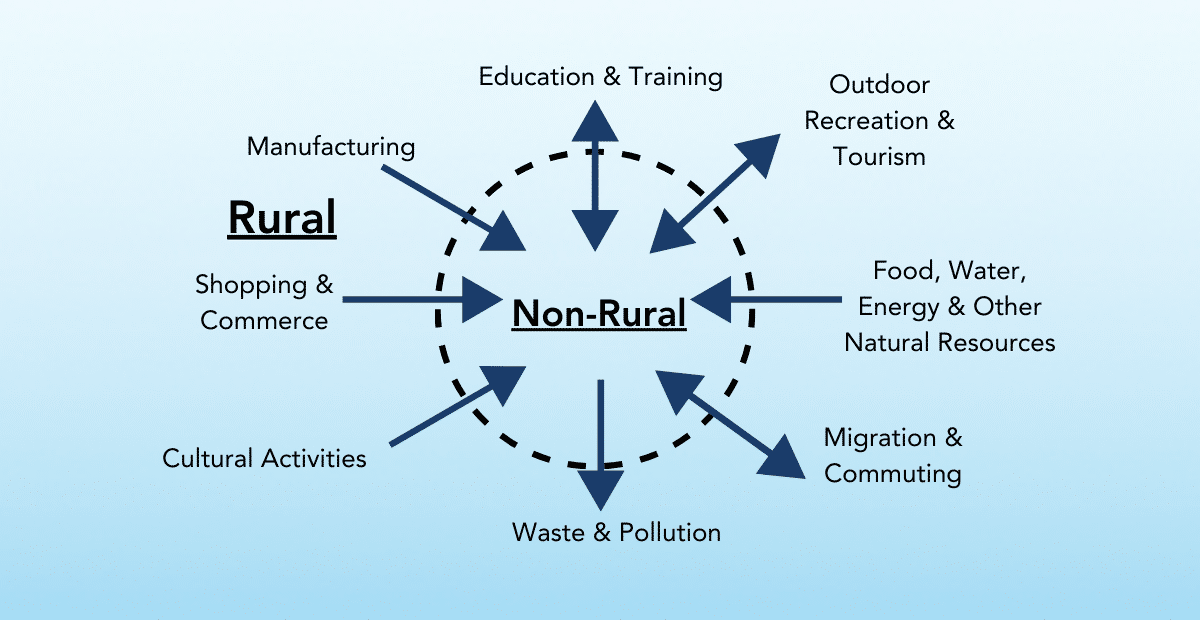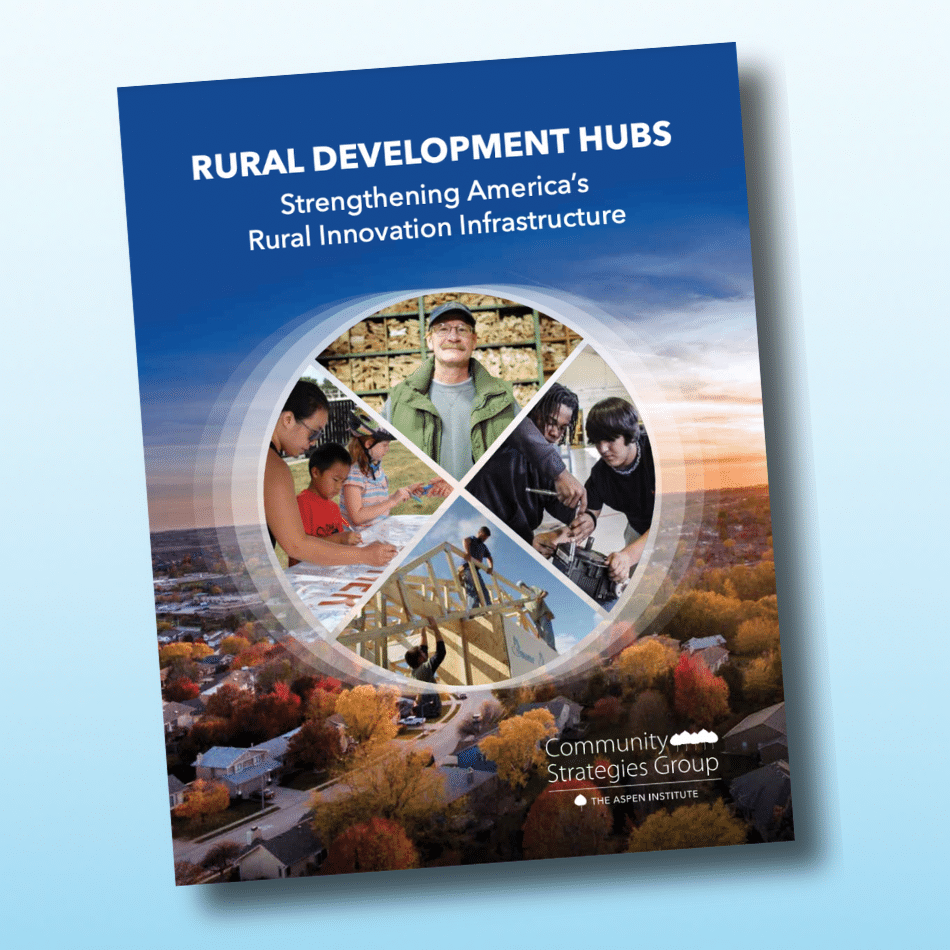This is the second in a series (see Part 1) on how to ensure development investments that are part of COVID-19 relief and recovery set the stage for thriving rural communities and a more distributed, inclusive US economy. It was cross-posted by the Brookings Institution. This article has been updated since its original posting in June 2020. On January 20, 2021, Katharine Ferguson joined the US Department of Agriculture as Chief of Staff. The ideas in this blog do not necessarily represent the policy of the USDA.
With President Biden newly inaugurated, debate still rages on whether to offer COVID-19 relief to state, local, and tribal governments, which are in acute fiscal crisis due to an unexpected double whammy: the direct costs associated with taking quick, decisive action to protect public health, and the indirect costs of loss of revenue that are the inevitable fallout of interrupted economic activity due to social distancing.
The case for significant federal intervention to support states and localities is practical: Since they have to operate within balanced budgets, the only way that states and localities can manage this sudden increase in demand and drop in revenue is to cut spending. They will have no choice but to reduce essential services such as waste management, education, health, and indigent care. The resulting short-term savings will only increase long-term costs, in the same way that a cavity left untreated leads to a root canal when a simple, inexpensive filling would have solved the problem.
The federal government can and should do what any good dentist would do: fill the gap in state and local budgets to prevent decay and promote long-term health.
While this immediate relief is necessary, it’s also apparent that a long-term recovery that simply returns us to a pre-COVID status quo is unsatisfactory. The crisis has revealed long-standing and pervasive racial and economic disparities. It has also exposed the extent to which place matters: The geographic inequities in economic outcomes that have grown over the past 15 years across the US have weakened the country’s resilience and reduced opportunity for too many Americans.
With COVID-19 laying bare the flaws of our current system, now is the time to reimagine how we invest in rural regions.
“Building back better” includes giving rural regions and tribal nations a fighting chance to thrive in a post-COVID economy. It includes addressing geographic disparities as well as racial disparities in life expectancy, educational attainment, household income, or health status. For more towns and communities across America to share in the benefits of recovery and take advantage of the opportunities offered by the modern economy to thrive, we must revamp federal rural policy.
Created for a different time and reality, current federal rural policy is not up to the task. With COVID-19 laying bare the flaws of our current system, now is the time to reimagine how we invest in rural regions, which include many tribal nations, and maximize the development return on every taxpayer dollar.
With the 1913 creation of the federal income tax and system of grant-in-aid to states, federal investment began to play a more important role in enabling rural America to finance local development efforts and thrive. The Farm Credit System, the Tennessee Valley Authority, Rural Electrification Administration, Civilian Conservation Corps, and Works Progress Administration brought capital, electricity, water, art, and jobs to previously disconnected and disadvantaged places, forever transforming many rural regions. While criticized for their racial policies and practices to varying degrees, the very existence of these institutions is a reminder of the vision and scale of federal involvement in development in the first half of the 20th century. The federal role in financing development and tackling social problems grew through the late 1960s with the creation of the Interstate Highway System, the War on Poverty, and the Civil Rights Act. The evolving role of the US government in tribal affairs and Indian Country development warrants its own review.
The share of federal grants to state and local governments to support education, infrastructure, and governance has declined since the 1980s, even as federal investments in Social Security and health insurance have grown. Such social investments, targeted at individuals, are vital to improving family economic security and health. However, concurrent investment in local governments and organizations fundamental to the functioning of a community is essential to enable healthy local economies, sustain improvements and quality of life, and reduce emerging or persistent inequity over the long run.
As we noted in the first piece in this series, we can improve the effectiveness of federal rural policy by following a set of principles that reflect the experience of rural practitioners and are informed by successful development practice internationally:
- Support local ownership and strategies.
- Invest in people and institutions.
- Increase flexibility and align federal funds to meet local needs.
- Measure and reward outcomes.
- Embrace a regional mindset.
Using these principles as a guide, we propose four big ideas to modernize federal assistance to advance development and do right by rural communities here at home. A regional approach is integral to all of these ideas and something we will explore in a separate piece down the road.
1. Bring strategy and coherence to US rural policy
On paper, the US Department of Agriculture (USDA) is charged with directing and coordinating federal rural policy. In reality, the issues affecting rural and tribal communities are wide-ranging and cut across numerous federal agencies and Congressional committees over which USDA has no jurisdiction and little or no influence. The result: a fragmented, alphabet soup of federal development programs that fund projects without a consistent intellectual framework.
With no real vision or true national rural strategy—and no one really “in charge” of rural issues—all too often the unique needs of rural and tribal communities fall through the cracks. This shows up as eligibility criteria that lock out rural applicants because the population is too low, the crime rate not high enough, the geography not contiguous. It also shows up as funding formulas that don’t account for the higher per capita costs of providing services in a rural area, or that automatically provide cities with funds while small, comparatively low-capacity places must prepare proposals and compete against one another.
Programs implemented in this way—with smaller places carrying higher fixed costs and doing more to get less—are a recipe for perpetuating geographic inequity. Taken together, these design decisions inadvertently create a “structural urbanism” that consistently disadvantages rural communities. The intention is often to “maximize impact” and ensure dollars are reaching the greatest number of people, yet the consequence is that less densely populated places, which are most at risk in a modern agglomeration economy, find themselves locked out of programs critical to development. A solution: Restructure the bureaucracy so its very design prompts consideration of “place” as well as “people”—to be sensitive to geographic inequity, especially in distressed or at-risk rural and tribal communities, including those susceptible to future shocks.
The list of ways to redesign in a rural-forward manner are many; here are a handful of high-impact places to start:
- Create a National Rural Strategy. Ideally, the government would be working from a clear, comprehensive and ambitious national rural strategy that is responsive to local circumstances. As a first step, domestic development leaders could look to other policy arenas for inspiration. The White House Office of National AIDS Policy, for example, crafts and implements the National HIV/AIDS Strategy, and formal policy guidance from the White House has helped international development agencies focus on a handful of game-changing goals. There are other options for how to set a national strategy: The important thing is to provide domestic agencies with direction and a decisionmaking structure based on a coherent federal policy.
- Elevate White House leadership for rural and tribal affairs. For any of this to work, there must be officials of sufficient stature at the White House, engaging directly with the Domestic Policy Council, National Economic Council, the Council for Environmental Quality and the myriad of federal agencies who are charged with thinking about the geographic ramifications of national policy and familiar with the unique needs of rural and tribal communities.
- Formalize consistent, apolitical interagency coordination. For decades, presidents have created rural commissions and rural councils, though often with a time-limited mandate or abbreviated lifespan; new administrations tend to dissolve the previous one and create a new one to their liking. Establishment of an independent body with leadership, funding and a clear, statutory mandate to promote rural development—one that bridges administrations such as the S. Interagency Council on Homelessness—would be an important step forward. Related: Created in 2010, the White House Council on Native American Affairs has proven invaluable and was recently reestablished; it should be codified, funded, elevated, and recognized as essential to fulfilling US treaty obligations.
- Conduct a rural impact audit and rural review. The Office of Management and Budget (OMB) could do what it does best: wield its power to prompt interagency review with a “rural impact audit” of existing laws, program criteria, and regulations to identify ways that current policies, funding formulas, and systems design are most problematic for rural and tribal communities— and which, if changed, would have the most impact. Concurrently, OMB could work with agencies to identify creative ways to create permanent and predictable revenue sources for development activities that adhere to the principles articulated above and have been proven to yield positive outcomes in communities.
2. Launch the American Challenge Corporation.
The urgency and constraints of a post-COVID recovery, combined with the complicated challenges posed by 21st century shifts in the national and global economy, demographics, and climate, require delivering federal assistance to communities differently. A new era deserves a new agency: the American Challenge Corporation (ACC), built from the ground up based on modern principles of effective development. The ACC would measure its success against an unwavering mission: Improve the well-being, self-sufficiency, and economic resilience of distressed and vulnerable US communities. Like any good business, the ACC would relentlessly focus on results, by investing in the vision and capacity of local leaders and their solutions, tracking outcomes closely, and disseminating state-of-the-art development know-how.
This proposal takes its inspiration from the success of the Millennium Challenge Corporation launched in 2005 by the Bush administration to reduce poverty overseas, and is informed by Congressional proposals such as the Native Millennium Challenge Demonstration Act and the Rebuild Rural America Act. There may be ways to expand the authorities of an existing institution or programs rather than start from scratch, but it is vital to have a modern, state-of-the-art enterprise that aligns with each of the development principles articulated above. The ACC would be fundamentally different than any existing US domestic agency or program by:
- Providing large, five-year grants through “compacts” proposed and led by local leaders and organizations, with the goal of growing locally-led economies, reducing poverty and strengthening institutions, while respecting self-determination and local control.
- Selecting investments through an objective, competitive process informed by independent indicators. To help communities strengthen their readiness and improve their probability of selection, the ACC would have a robust “readiness” program that offers smaller grants, capacity-building assistance, and targeted support.
- Providing flexibility so that compacts are customized and designed to most cost-effectively achieve impact, to meet the unique needs and opportunities of communities, and to be adjusted as necessary during the life of the grant.
- Using a data-driven approach that invests in evaluation and rigorous analyses to identify community assets and assess high-value interventions, and that transparently measures the economic, environmental, and health outcomes of its programs.
Given that rural regions, including tribal nations, were the slowest to recover from the 2008 recession and have the highest prevalence of persistent poverty, we recommend that funding from the ACC be limited to rural communities and tribal nations in its first five years. It could then expand to a broader set of communities.
3. Elevate and expand domestic development finance.
Five-year grants like those described above will create initial momentum, but sustaining locally-led economic activity sufficient to improve community outcomes also requires adequate and relevant long-term financing options. Finding right-sized, affordable, patient capital is challenging in rural and tribal regions where market-rate financing often remains unaffordable, unavailable, or both.
Rural America had 33 percent fewer entrepreneurs operating businesses in 2018 than 1988, and the loss of community banks—40 percent of rural counties lost bank branches between 2012-2017—means those local entrepreneurs have difficulty finding financing to suit their particular needs. Communities are also challenged by significant infrastructure needs, especially broadband connectivity. Persistent poverty regions are chronically underserved, and a growing set of communities are newly vulnerable due to rapid economic shift in now-declining industries such as coal, timber, or manufacturing.
Some rural and tribal areas benefit from mission-driven institutions (e.g., Community Development Financial Institutions (CDFIs), Farm Credit System institutions, and Community Development Corporations) that federal policy enables. There are also a wide range of existing financing tools and loan funds dispersed throughout federal agencies. These are limited, however, by narrow authorities and mandates (e.g., housing, agriculture) and, as a whole, are significantly undercapitalized.
The result: fragmented financing sources with limited ability to take risks, innovate, and respond to community vision in a broad-based and ever-evolving way. It is time for the US to leverage its experience and history in innovative finance and elevate and expand the public development financing available to underserved areas in the US.
One model would be to create a new development finance institution (DFI) that builds upon existing tools and programs. This follows the template of the new US International Development Finance Corporation, created by the 2018 BUILD Act, which has considerably strengthened the US government’s muscle overseas by combining complementary programs and financing mechanisms that existed in different agencies; taking on new, flexible authorities, such as the ability to make equity investments; and adding capital.
There is precedent for this: The US has had national development banks in the past, including the Reconstruction Finance Corporation (RFC) during the Great Depression. In fact, the RFC was the model for one of the world’s most successful current DFIs, Germany’s KfW, which the US helped create out of the Marshall Plan. KfW benefits from shared governance, with 80 percent of its ownership held by the national government and 20 percent by German states.
A national DFI would have greater flexibility and power to direct resources toward national-level strategic interests—for example, making it a priority for sufficient financing to reach rural and tribal areas—and to drive innovation that addresses unique financing needs than is possible within our current fragmented structure. Other models may achieve the same goal. This much is clear: To meet the urgency and scope of demand in underserved communities, the US must be as ambitious and creative at financing development here at home as it is abroad.
4. Elevate capacity building and evaluation.
Strengthening local institutions is fundamental to increasing local self-reliance and to shifting federal and state support away from supporting “projects” and toward supporting proven development strategies. Evaluation and the collection of more relevant data on activities and results are needed to create a feedback loop and understand what is achieved. To improve existing programs and maximize the development return, for every $90 dollars in federal funds invested in rural and community economic development, another $5 should be provided for local capacity building, with $5 more dedicated to program evaluation.
The term “capacity building” describes a wide-ranging set of activities that build the skills, governance processes, and finances of an organization or agency so it is stronger, more effective, and more sustainable. Evaluation entails intentionally collecting and analyzing quantitative and qualitative data on if and how a program is successful—and why.
Capacity building, evaluation, and adaptive learning are fundamental to modern international development successes that emphasize local ownership and facilitate continual improvement. By contrast, current federal investments in domestic community and economic development rarely allow funds to be used for either capacity building or evaluation. As a result, local leaders rarely have the necessary time or people to further develop or pursue locally-led innovations or solutions, and rural and tribal data lacks rigor that would be helpful to advance development.
The bottom line, we recommend this simple reform to existing programs: 5 percent mandated for capacity building, and 5 percent for evaluation. It will yield more autonomous communities and stronger local institutions, and increase transparency. It will also enhance our ability to continually improve programs, so we make better use of taxpayer dollars and more effectively improve economic, social, and health outcomes in rural and tribal communities.
COVID-19 is reminding us how integral rural and tribal communities are to strengthening America’s competitiveness and resilience. The health of farmworkers in the Central Valley of California affects what shows up on shelves in Chicago; a rural North Carolina textile company retooling to make PPE means a safer workplace for front-line health workers in New York City.
Whether renewing small businesses, growing local ownership, strengthening regional supply chains for essential goods and services, or shifting to environmentally friendly energy, successfully reaching rural and tribal communities will require a coherent strategy, a commitment to investing in local people and institutions, and innovative tools of development finance. With nothing less than American competitiveness and the future of communities at stake, an agenda to modernize federal investments in rural and tribal communities and maximize the impact of every development dollar here at home deserves bipartisan support and attention.
Katharine Ferguson was formerly the Associate Director of the Aspen Institute Community Strategies Group and Director of CSG’s Rural and Regional Initiatives. She is currently the Chief of Staff for the US Department of Agriculture.
Tony Pipa is a senior fellow in the Global Economy and Development Program at the Brookings Institution, where he studies place-based policies to improve social progress in the United States and globally; he has over 25 years of executive experience in the philanthropic and public sectors addressing poverty and advancing inclusive economic development both in the US and abroad.
Support for this article was provided in part by the Robert Wood Johnson Foundation. The views expressed here do not necessarily reflect the views of the Foundation.







